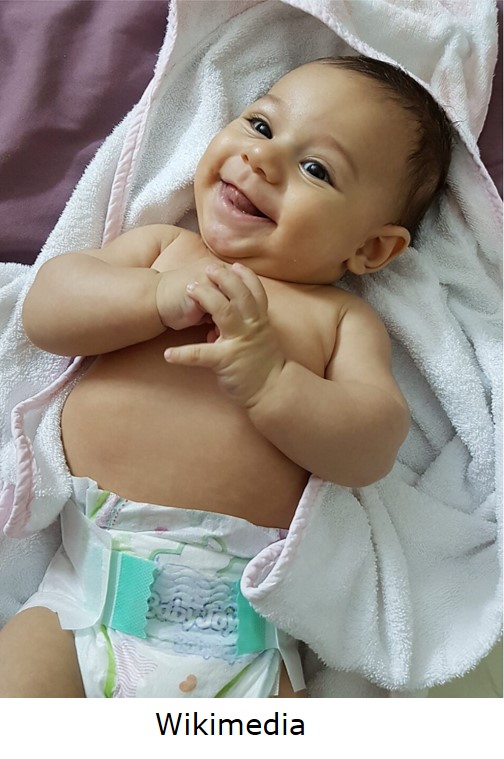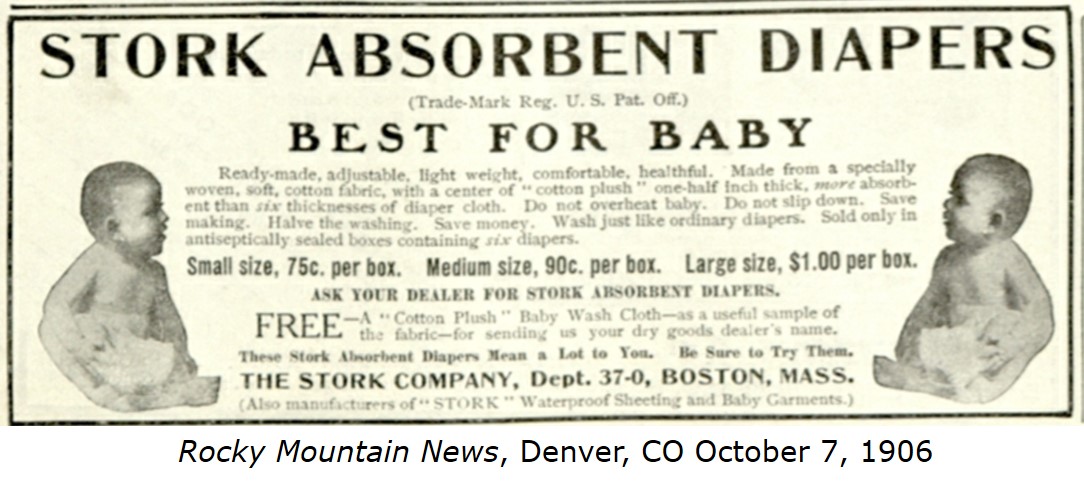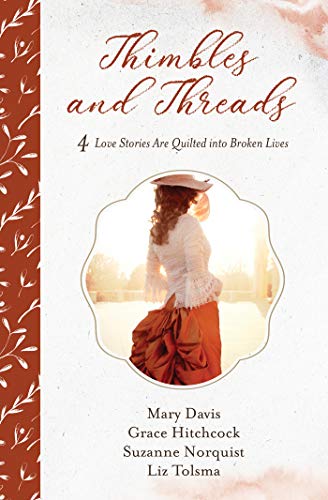By Suzanne
Norquist
As a new
grandmother, I find myself discussing diapers with my daughter. Like an old
woman, I say things like, “In my day, there were rubber pants . . . but they
were made of plastic, not rubber.”
And, “Think of those old-time pictures where small children wore no pants at all.” She says, “No thanks” to that mess. At the same time, I realize that many climates are too cold for bare bottoms.
And so here
is a blog about the history of diapers.
In warm
climates, parents often left their babies’ bottoms bare. To prevent messes,
they learned how to anticipate when the child needed to go. There is a
technique called “elimination communication,” which sounds more like potty
training for parents. This method was used until recently in China. When the
need arose, a mother could hold the baby over a pot or out in the street.
In cold climates, parents made a diaper out of animal skin lined with moss or grass. Where cloth was available, it would be layered to keep the child clean. Europeans swaddled their babies in linen. Although this sounds cozy, the fabric wasn’t changed often or cleaned well. No one knew that cleanliness prevented diseases.
Cloth diapers, as we think of them, didn’t really appear until the late 1800s. With the Industrial Revolution, more people had nice furniture to protect. At that time, machines could make cloth, and safety pins had been invented. In 1887, Marie Allen created the first mass-produced cloth diapers in the United States.
Because people had learned about germs, they boiled diapers and hung them out to dry.
Of course,
mothers and seamstresses continued to refine the design, even if only within
their small circle. In an 1897 article in the Rocky Mountain News,
Denver, CO, Mrs. Bertha Janet Gunn describes concerns about most diapers.
“A
heavy diaper, for instance, which always holds the child’s legs out, or the
flannel bellyband which is pulled so tightly around its yielding little body,
and fastened with pins that are forever in danger of slipping out and sticking
into its delicate flesh.”
She created
patterns to solve these problems and sold both patterns and pre-made diapers.
“My
diaper is cut on the bias, so the seat is larger and baggy, and there is very
little cloth to fold between the legs, so the little legs can lie straight
out.”
Accidents
were common since cloth doesn’t stop all moisture from leaking out. In the
1920s, parents often put rubber pants over the fabric. However, rubber tended
to irritate the skin. In the 1950s, plastic pants replaced them, but they were
still called “rubber pants.”
Newspaper advertisements in the early 1900s promoted various types of diapers, including double diapers, linen diapers, cotton diapers, and rubber diapers.
Disposable ones improved the quality of life for generations of moms and babies. In the 1940s, when World War II caused a shortage of cotton, moms got creative, leading to the invention of the disposable diaper. Several people are credited with the idea.
Some of the first efforts included a Swedish paper company that attempted to use sheets of tissue pads. Rubber pants kept it all in, but it resulted in mushy balls of paper. A Scottish woman used old
parachutes for the outside with cellulose wadding and cotton wool inside. This
product never took off.
In the late 1940s, Marion Donovan used shower curtain material to create a leak-proof diaper cover. Her design included snap fasteners instead of safety pins. This product, known as the Boater because it resembled a boat, was used with cloth diapers. However, it inspired disposable diaper makers. Layered tissue paper (which must be sturdier than what the Swedish paper company used) could be used instead of cloth.
In 1961, Procter and Gamble brought Pampers to market. Employee and grandfather Vic Mills saw room for improvement in existing products. He used cellulose instead of paper fibers for better absorption.
Over time,
other companies entered the market. Improvements included increased absorbency,
an hourglass shape, elastic in the legs, biodegradable materials, and
additional features.
Now, parents can choose between improved versions of cloth diapers or disposables. New moms, like my daughter, will never know the frustration of pinning an ill-fitting cloth diaper on her baby and pulling a plastic pant over the top.
***
”Mending Sarah’s Heart” in the Thimbles and Threads Collection
Four
historical romances celebrating the arts of sewing and quilting.
Mending
Sarah’s Heart by Suzanne Norquist
Rockledge,
Colorado, 1884
Sarah
seeks a quiet life as a seamstress. She doesn’t need anyone, especially her
dead husband’s partner. If only the Emporium of Fashion would stop stealing her
customers, and the local hoodlums would leave her sons alone. When she rejects
her husband’s share of the mine, his partner Jack seeks to serve her through
other means. But will his efforts only push her further away?
Suzanne Norquist is the author of two novellas, “A Song for Rose” in A Bouquet of Brides Collection and “Mending Sarah’s Heart” in the Thimbles and Threads Collection. Everything fascinates her. She has worked as a chemist, professor, financial analyst, and even earned a doctorate in economics. Research feeds her curiosity, and she shares the adventure with her readers. She lives in New Mexico with her mining engineer husband and has two grown children. When not writing, she explores the mountains, hikes, and attends kickboxing class.














Such a fun article! I'm so glad my kids were born in a era when we had the option of sticky tabs instead of pins! I remember changing my brother's cloth diapers and poking him a few times! No wonder he didn't like me for the first five years of his life! :)
ReplyDeleteI love your post! I remember my folks calling them rubber pants, too. My girls wore only cloth diapers, with diaper pins and plastic pants. I used a diaper pin and string to hold my daughter's binky to her clothing so it wouldn't fall in the floor. When they invented the binky holders I thought gee, I should have invented them, lol!
ReplyDeleteThanks for posting. Congratulations on your grandchild's birth! You brought back memories of smelly diaper pails, lol. I do like the new diapers that are disposable, but there are times when you really need a cloth diaper.
ReplyDelete